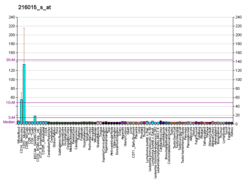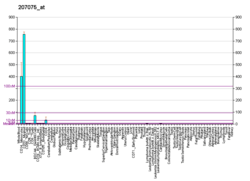NALP3
NACHT, LRR and PYD domains-containing protein 3 (NALP3), also known as cryopyrin, is a protein that in humans is encoded by the NLRP3 gene[5] located on the long arm of chromosome 1.[6]
NALP3 is expressed predominantly in macrophages and as a component of the inflammasome,[7][8]:436 detects products of damaged cells such as extracellular ATP and crystalline uric acid. Activated NALP3 in turn triggers an immune response. Mutations in the NLRP3 gene are associated with a number of organ specific autoimmune diseases.
Nomenclature
NACHT, LRR, and PYD are respectively acronyms for:
- NACHT – NAIP (neuronal apoptosis inhibitor protein), C2TA [class 2 transcription activator, of the MHC, HET-E (heterokaryon incompatibility) and TP1 (telomerase-associated protein 1)
- LRR – "leucine-rich repeat" [9][10] and is synonymous with NLR, for or nucleotide-binding domain, leucine-rich repeat"[11]
- PYD – "PYRIN domain," after the pyrin proteins[12] The NLRP3 gene name abbreviates "NLR family, pyrin domain containing 3," where NLR refers to "nucleotide-binding domain, leucine-rich repeat."[13]
The NACHT, LRR and PYD domains-containing protein 3 is also called:
- cold induced autoinflammatory syndrome 1 (CIAS1),
- caterpiller-like receptor 1.1 (CLR1.1), and
- PYRIN-containing APAF1-like protein 1 (PYPAF1).[14]
Structure
This gene encodes a pyrin-like protein which contains a pyrin domain, a nucleotide-binding site (NBS) domain, and a leucine-rich repeat (LRR) motif. This protein interacts with pyrin domain (PYD) of apoptosis-associated speck-like protein containing a CARD (ASC). Proteins which contain the caspase recruitment domain, CARD, have been shown to be involved in inflammation and immune response.[5]
Function
NALP3 is a component of the innate immune system that functions as a pattern recognition receptor (PRR) that recognizes pathogen-associated molecular patterns (PAMPs).[15] NALP3 belongs to the NOD-like receptor (NLR) subfamily of PRRs and NALP3 together with the adaptor ASC protein PYCARD forms a caspase-1 activating complex known as the NALP3 inflammasome. NALP3 in the absence of activating signal is kept in an inactive state complexed with HSP90 and SGT1 in the cytoplasm. NALP3 inflammasome detects danger signals such as crystalline uric acid and extracellular ATP released by damaged cells. These signals release HSP90 and SGT1 from and recruit ASC protein and caspase-1 to the inflammasome complex. Caspase-1 within the activated NALP3 inflammasome complex in turn activates the inflammatory cytokine, IL-1β.[15]
The NALP3 inflammasome appears to be activated by changes in intracellular potassium caused by potassium efflux from mechanosensitive ion channels located in the cell membrane.[16] It appears that NALP3 is also regulated by reactive oxygen species (ROS), though the precise mechanisms of such regulation has not been determined.[17]
It is suggested that NALF3 provides protection against Streptococcus pneumoniae infections by activating STAT6 and SPDEF.[18]
Pathology
Mutations in the NLRP3 gene have been associated with a spectrum of dominantly inherited autoinflammatory diseases called cryopyrin-associated periodic syndrome (CAPS). This includes familial cold autoinflammatory syndrome (FCAS), Muckle–Wells syndrome (MWS), chronic infantile neurological cutaneous and articular (CINCA) syndrome, neonatal onset multisystem inflammatory disease (NOMID), and keratoendotheliitis fugax hereditaria.[5][19]
Defects in this gene have also been linked to familial Mediterranean fever.[20] In addition, the NALP3 inflammasome has a role in the pathogenesis of gout[15] and neuroinflammation occurring in protein-misfolding diseases, such as Alzheimer's, Parkinson's, and prion diseases.[21][22][23] Amelioration of mouse models of many diseases has been shown to occur by deletion of the NLRP3 inflammasome, including gout, type 2 diabetes, multiple sclerosis, Alzheimer's disease, and atherosclerosis.[24] The ketone β-Hydroxybutyrate has been shown to block NLRP3 activation, and thus may be of benefit for many of these diseases.[25]
Deregulation of NALP3 has been connected with carcinogenesis. For example, all the components of the NALP3 inflammasome are downregulated or completely lost in human hepatocellular carcinoma.[26]
References and notes
- GRCh38: Ensembl release 89: ENSG00000162711 - Ensembl, May 2017
- GRCm38: Ensembl release 89: ENSMUSG00000032691 - Ensembl, May 2017
- "Human PubMed Reference:". National Center for Biotechnology Information, U.S. National Library of Medicine.
- "Mouse PubMed Reference:". National Center for Biotechnology Information, U.S. National Library of Medicine.
- Anon. (2015). "Entrez Gene: NLRP3 NLR family, pyrin domain containing 3 [Homo sapiens (human)], Gene ID: 114548 (updated on 13-Nov-2015)". Bethesda, MD, USA: National Center for Biotechnology Information, National Library of Medicine. Retrieved 13 November 2015.
- Hoffman HM, Wright FA, Broide DH, Wanderer AA, Kolodner RD (May 2000). "Identification of a locus on chromosome 1q44 for familial cold urticaria". American Journal of Human Genetics. 66 (5): 1693–8. doi:10.1086/302874. PMC 1378006. PMID 10741953.
- Tao JH, Zhang Y, Li XP (Dec 2013). "P2X7R: a potential key regulator of acute gouty arthritis". review. Seminars in Arthritis and Rheumatism. 43 (3): 376–80. doi:10.1016/j.semarthrit.2013.04.007. PMID 23786870.
- Lu A, Wu H (Feb 2015). "Structural mechanisms of inflammasome assembly". review. The FEBS Journal. 282 (3): 435–44. doi:10.1111/febs.13133. PMC 6400279. PMID 25354325.
- Koonin EV, Aravind L (May 2000). "The NACHT family - a new group of predicted NTPases implicated in apoptosis and MHC transcription activation". Trends in Biochemical Sciences. 25 (5): 223–4. doi:10.1016/S0968-0004(00)01577-2. PMID 10782090.
- Pueyo I, Jiménez JR, Hernández J, Brugarolas A, García-Morán M, García-Muñiz JL, Arroyo F (Sep 1978). "Carcinoid syndrome treated by hepatic embolization". AJR. American Journal of Roentgenology. 131 (3): 511–3. doi:10.2214/ajr.131.3.511. PMID 99001.
- Jha S, Ting JP (Dec 2009). "Inflammasome-associated nucleotide-binding domain, leucine-rich repeat proteins and inflammatory diseases". Journal of Immunology. 183 (12): 7623–9. doi:10.4049/jimmunol.0902425. PMC 3666034. PMID 20007570.
- Bertin J, DiStefano PS (Dec 2000). "The PYRIN domain: a novel motif found in apoptosis and inflammation proteins". review. Cell Death and Differentiation. 7 (12): 1273–4. doi:10.1038/sj.cdd.4400774. PMID 11270363.
- Jha S, Ting JP (Dec 2009). "Inflammasome-associated nucleotide-binding domain, leucine-rich repeat proteins and inflammatory diseases". review. Journal of Immunology. 183 (12): 7623–9. doi:10.4049/jimmunol.0902425. PMC 3666034. PMID 20007570.
- Q96P20
- Martinon F (Mar 2008). "Detection of immune danger signals by NALP3". review. Journal of Leukocyte Biology. 83 (3): 507–11. doi:10.1189/jlb.0607362. PMID 17982111.
- Hari A, Zhang Y, Tu Z, Detampel P, Stenner M, Ganguly A, Shi Y (2014). "Activation of NLRP3 inflammasome by crystalline structures via cell surface contact". Scientific Reports. 4: 7281. Bibcode:2014NatSR...4E7281H. doi:10.1038/srep07281. PMC 4250918. PMID 25445147.
- Haneklaus M, O'Neill LA, Coll RC (Feb 2013). "Modulatory mechanisms controlling the NLRP3 inflammasome in inflammation: recent developments". review. Current Opinion in Immunology. 25 (1): 40–45. doi:10.1016/j.coi.2012.12.004. hdl:2262/72554. PMID 23305783.
- Fang, Rendong; Uchiyama, Ryosuke; Sakai, Shunsuke; Hara, Hideki; Tsutsui, Hiroko; Suda, Takashi; Mitsuyama, Masao; Kawamura, Ikuo; Tsuchiya, Kohsuke (2019). "ASC and NLRP3 maintain innate immune homeostasis in the airway through an inflammasome-independent mechanism". Mucosal Immunology. 12 (5): 1092–1103. doi:10.1038/s41385-019-0181-1. ISSN 1933-0219. PMID 31278375.
- Turunen JA, Wedenoja J, Repo P, Järvinen RS, Jäntti JE, Mörtenhumer S, Riikonen AS, Lehesjoki AE, Majander A, Kivelä TT (Jan 2018). "Keratoendotheliitis Fugax Hereditaria: A Novel Cryopyrin-Associated Periodic Syndrome Caused by a Mutation in the Nucleotide-Binding Domain, Leucine-Rich Repeat Family, Pyrin Domain-Containing 3 (NLRP3) Gene". American Journal of Ophthalmology. 184: 41–50. doi:10.1016/j.ajo.2018.01.017. PMID 29366613.
- Church LD, Cook GP, McDermott MF (Jan 2008). "Primer: inflammasomes and interleukin 1beta in inflammatory disorders". review. Nature Clinical Practice Rheumatology. 4 (1): 34–42. doi:10.1038/ncprheum0681. PMID 18172447.
- Liu-Bryan R (Jan 2010). "Intracellular innate immunity in gouty arthritis: role of NALP3 inflammasome". review. Immunology and Cell Biology. 88 (1): 20–3. doi:10.1038/icb.2009.93. PMC 4337950. PMID 19935768.
- Heneka MT, Kummer MP, Stutz A, Delekate A, Schwartz S, Vieira-Saecker A, Griep A, Axt D, Remus A, Tzeng TC, Gelpi E, Halle A, Korte M, Latz E, Golenbock DT (Jan 2013). "NLRP3 is activated in Alzheimer's disease and contributes to pathology in APP/PS1 mice". Nature. 493 (7434): 674–8. Bibcode:2013Natur.493..674H. doi:10.1038/nature11729. PMC 3812809. PMID 23254930.
- Shi F, Kouadir M, Yang Y (Aug 2015). "NALP3 inflammasome activation in protein misfolding diseases". review. Life Sciences. 135: 9–14. doi:10.1016/j.lfs.2015.05.011. PMID 26037399.
- Levy M, Thaiss CA, Elinav E (2015). "Taming the inflammasome" (PDF). Nature Medicine. 21 (3): 213–215. doi:10.1038/nm.3808. PMID 25742454.
- Youm YH, Nguyen KY, Grant RW, Goldberg EL, Bodogai M, Kim D, D'Agostino D, Planavsky N, Lupfer C, Kanneganti TD, Kang S, Horvath TL, Fahmy TM, Crawford PA, Biragyn A, Alnemri E, Dixit VD (2015). "The ketone metabolite β-hydroxybutyrate blocks NLRP3 inflammasome-mediated inflammatory disease". Nature Medicine. 21 (3): 263–269. doi:10.1038/nm.3804. PMC 4352123. PMID 25686106.
- Wei Q, Mu K, Li T, Zhang Y, Yang Z, Jia X, Zhao W, Huai W, Guo P, Han L (Jan 2014). "Deregulation of the NLRP3 inflammasome in hepatic parenchymal cells during liver cancer progression". Laboratory Investigation. 94 (1): 52–62. doi:10.1038/labinvest.2013.126. PMID 24166187.
External links
- Overview of all the structural information available in the PDB for UniProt: Q96P20 (NACHT, LRR and PYD domains-containing protein 3) at the PDBe-KB.





